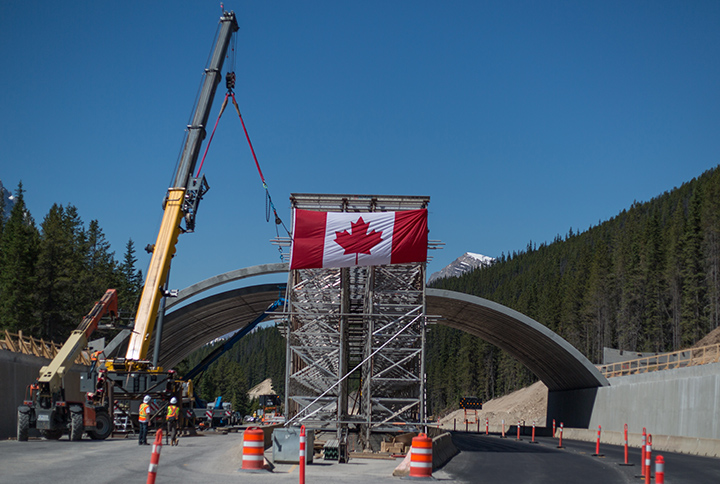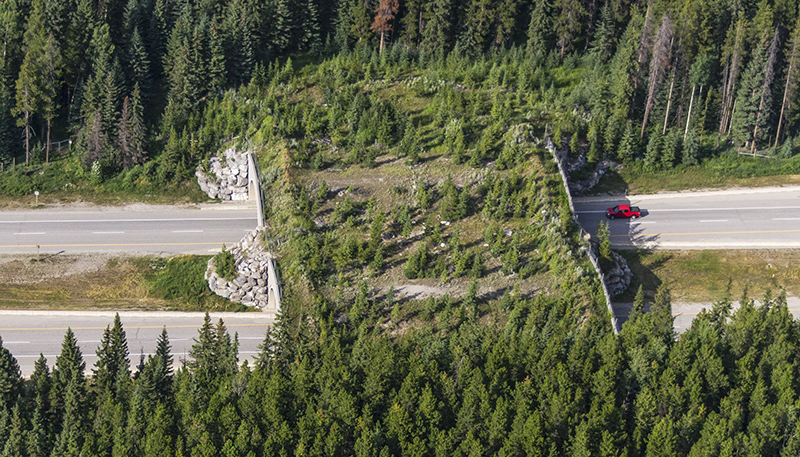Striking the balance between cost and environmental benefit to optimize wildlife crossing design
Banff National Park, in the heart of the Yellowstone to Yukon region, is home to the world’s best studied wildlife crossing system.
The six overpasses and 38 underpasses between east gate of Banff National Park and British Columbia-Alberta border make the highest concentration of wildlife crossing structures for any single stretch of highway anywhere in the world.
They are also highly successful. Research shows this network of crossings and wildlife fencing reduced wildlife collisions by 80 percent, and for just deer and elk by 96 percent (Clevenger et al., 2001).
Thanks to decades of monitoring and studies on these highly effective wildlife crossings, we have learned a lot about what makes these key pieces of connectivity infrastructure work effectively.
For example, a crossing with fencing works best, as it guides wildlife to the crossing point (Huijser et al., 2009). We also know that some species prefer certain styles of crossing. Grizzly bears, elk, moose and deer prefer wildlife crossings that are large, open overpasses as opposed to cougars, for example, who prefer long, low and narrow underpasses. (iClevenger & Waltho, 2005; Kusak et al., 2009)
As the construction of wildlife crossing structures becomes increasingly common, the need for research of the economic impact, such as the investment of construction costs and payoff, has grown.
Past research shows costs to society due to wildlife-vehicle collisions on specific stretches of highway often exceed the expense of building a structure that allows animals to safely cross the road. It can cost society more to do nothing to address wildlife-vehicle collisions than it costs to build a crossing structure (Huijser et al. 2009).
In new research out today, biologists summarized the dimensions, effectiveness, and associated expert guidelines of overpasses around the world.
This research matters, because although there is evidence wildlife crossing infrastructure is highly effective, the design and construction of wildlife crossings often depend on government funding and budgets. While there is a need to balance economic costs, the crossing design must also work for wildlife.

Researchers looked at 120 overpasses around the world, and found the average structure was 34m wide. For a subset of overpasses in western North America, crossings that were wider (~50m) had almost twice the number of crossings than narrower ones, and from a more diverse set of species.
These findings support the need for ample overpasses at least 50m wide, especially when targeting a varied set of species or species particularly sensitive to overpass width. This width allows wildlife to cross the roads that cross their habitat, to find mates, food and habitat, but also strike the balance between economic cost and benefit to wildlife. If a crossing is particularly long, there is a recommendation for the width to increase as well.
Researcher Liam Brennan says, “There is little agreement on a global standard for what works best for construction costs and wildlife. We hope our research helps propel this discussion forward, to find the best definition of what works best for people and wildlife.”
By investing in infrastructure projects that lower wildlife-vehicle collisions and improve connectivity for animals, communities can also benefit provide benefit through job creation, infrastructure resiliency, and sustainable natural resources.
That’s a win-win.
Read the paper now
Brennan L, Chow E, Lamb C. 2022. Wildlife overpass structure size, distribution, effectiveness, and adherence to expert design recommendations. PeerJ 10:e14371 https://doi.org/10.7717/peerj.14371



